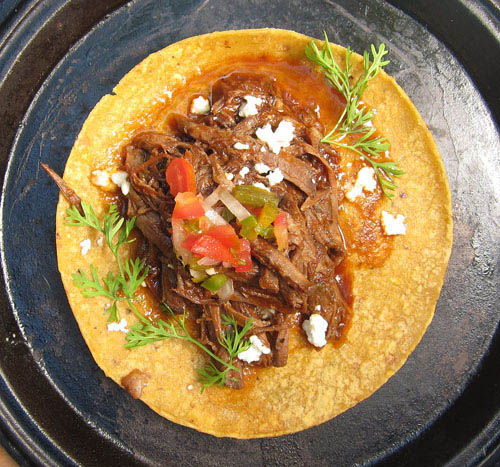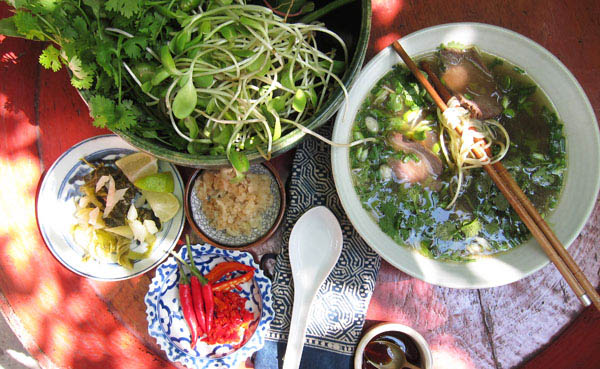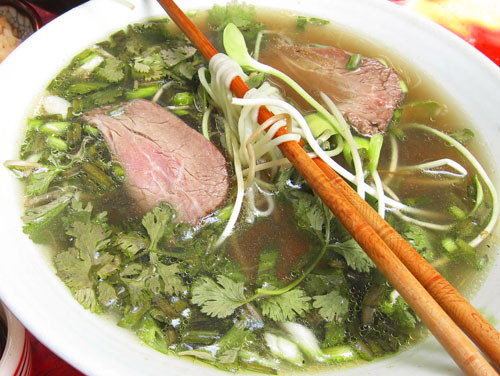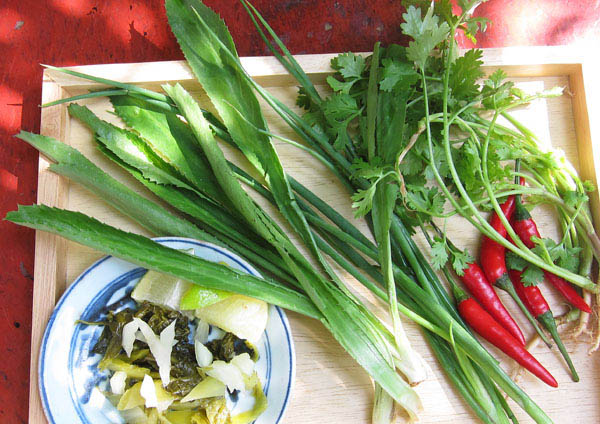Meats

Beef Barbacoa
Watching Christina Martinez making barbacoa in her South Philly Barbacoa restaurant (Chef’s Table, Se 5 Eps 1, Netflix) was, for me, the next best thing to being back in Mexico where food celebrates the very heart and soul of the country and its people.
Barbacoa originates from the central plains east of Mexico City where traditionally a lamb or a goat is slowly steamed in a deep pit lined with rocks preheated by a wood fire. The meat is marinated and wrapped in maguey (agave) leaves and steamed underground overnight. Cooking a barbacoa in Mexico is all about having a special meal for large family gatherings on weekends and for special holidays and fiestas.

Beef Barbacoa
A deeply flavored succulent Barbacoa is built around using a variety of locally grown sun dried chiles, traditional herbs and spices, and a seasoned cook’s attention to the nuances of slow cookery and taste. Most Ingredients can be found in Mexican shops and markets, in some super markets, or online. Once you have your sourcing resolved, you will find yourself making barbacoa on a regular basis. This is the kind of authentic Mexican food everyone loves to eat!
That said, home cooks can replicate a traditional barbacoa with a few adaptations in their own kitchen oven. No pit required.
I would suggest using beef or pork in lieu of lamb or goat unless you and your friends and family are seasoned regional Mexican food enthusiasts. Goat in particular is definitely an acquired taste and best cooked outside.
Making a barbacoa requires both time and effort, but you will will be abundantly rewarded with a truly authentic taste of Mexico. If time is a real issue you may want to speed up the cooking time using a pressure cooker or instant pot. Another tip, barbacoa freezes beautifully so you may want to double or triple the recipe and have barbacoa nearly ready on demand.
Beef Barbacoa  serves 6
Meat:
- 2.2 pounds/ 1 kilo beef brisket or chuck roast (or pork shoulder) cut into 3 equal size pieces, trimming off excess fat and skin
Marinade:
- juice of 1 orangeÂ
- juice of 2 limes
- 1 small onion, peeled and finely diced
- 1 teaspoon dried marjoram or Mexican oregano
- 1 teaspoon toasted cumin seeds, ground
- ¼ cup cider or white vinegar
- 1 teaspoon sea salt
Combine all of the marinade ingredients in a non-reactive bowl just large enough to hold the meat. Stir the marinade and add the meat, pressing the meat firmly down into the marinade to cover.
Cover the bowl with cling film and marinate for at least 4 hours or overnight.
Adobo Sauce:
- 8 dried New Mexico Red or Mexican Guajillo chiles
- 3 dried ancho chiles
- 2 dried smoked chipotle chiles
- 4 large garlic cloves, dry roasted and peeled
- 1 small onion, peeled, chopped
- 1 tablespoon peanut oil
- 1 teaspoon toasted cumin seeds, ground
- 1 teaspoon dried marjoram
- ½ teaspoon freshly ground black pepper
- ¼ teaspoon ground clove
- ½ teaspoon sugar
- 1 tablespoon cider vinegar
- 1 ½ teaspoons sea salt or to taste
Heat a skillet over medium heat. When hot place some of the dried chiles in the skillet without crowding. Using a spatula, press the chiles against the bottom of the skillet and toast them for 30 to 45 seconds. Turn the chiles and repeat, remove them, and set aside. This dry toasting intensifies the flavor of the chiles.
When the dry toasted chiles are cool enough to handle remove the stems, slit them open lengthwise, remove all the seeds and discard. Then tear the chiles into pieces and place them in a saucepan. Add enough water to cover and bring the pot to a simmer. Simmer for about 15 minutes and then set aside to cool. Drain the chiles, discard the cooking water, and set the chiles aside.
Using a blender, add the prepared softened dried chiles, sauteed onions, cumin, marjoram, black pepper, clove, sugar, cider vinegar, and salt. Blend all the ingredients together, scraping down the sides of the blender jar as needed, adding water as needed, until the sauce is very smooth. This may take several minutes.
Place a fine mesh strainer over a bowl and, using a silicon spatula, press the pureed sauce through the strainer until all the liquid has been extracted. Be sure to scrape off the residual sauce on the underside of the mesh strainer into the sauce. Taste the sauce and add salt as needed.
Transfer the adobo sauce to a container, cover, and refrigerate.
Preheat the oven to 275 F/Â 135 C
For roasting/steaming:
- 1 small onion, peeled, quartered and separated
- 4 garlic cloves peeled and thinly sliced lengthwise
- 6 bay leaves
- 6 whole cloves
- sea salt
- freshly ground black pepper
- 1 tomato blanched, skin removed and quartered, core removed
- 2 jalapeno or fresh red chiles, quartered and seeds removed
Select a Dutch oven with a tight fitting lid or a roasting pan. Place a shallow rack in the bottom of the pan of choice.
Remove the meat from the marinade and place it on the rack in the pan and add the marinade. Add just enough water to the pan to raise the level of liquid in the pan to about half way up the side of the meat.
Distribute the onions over the meat and tuck in garlic, bay leaves, and cloves. Season with salt and pepper, and top with tomatoes and jalapeno slices.
Cover the pan with a lid or tightly secured foil and transfer to the oven. Set the timer for 4 hours. Then check to see if there is sufficient liquid in the pan. If not replenish as needed. Repeat this every 2 hour until the beef is very tender and easily separated with a fork. Total cooking time will be between 7 and 9 hours. The longer the cooking time the more tender and flavorful the meat!
Once the meat is fully cooked set it aside covered until you are ready to serve.
Before serving you will want to remove the excess rendered fat gathered on top of the pan juices. Discard the fat or save for another purpose, like frying beans.
Before serving pull the beef apart using and reheat the reserved adobo sauce. The adobo should be the consistency of cream. If needed thin with pan juices. Spoon some adobo sauce over the pulled meat and serve the remaining adobo sauce in a bowl on the tables.
Serving:
- corn and flour tortillas, warmed in a hot dry skillet (or comal, pictured)Â
- Salsa fresca Â
- salsa verde
- quesso fresca or mild feta
Place the Barbacoa in the cooking pan on the table along with corn and flour tortillas. Set out salsa and the quesso fresca for those who want to make barbacoa tacos.

Borlotti Beans with Sausage
I just love beans, any which way, and I’m always trying out new variations just to keep the dialogue evolving. And, of course, it is fall and a perfect time for cooking beans for some hearty cool weather meals.
Borlotti beans may not be as popular as many other bean varieties, but why not try something new. Borlotti beans, also known as cranberry beans, originate from Mesoamerica and first cultivated in Colombia. The Colombian caramauto beans eventually found their way to Italy where they are favored for their thicker skin, creamier texture, and nutty flavor when cooked. Fresh borlotti beans have a pale buff background color streaked with red. Dried borlotti beans vary in color and are popular in Portuguese, Turkish, and Greek, as well as Italian cooking.
Like all common dried beans, Borlotti beans are cooked in a seasoned broth until soft. A flavorful meat is often added to the beans to give them an enticing aroma as well as a tantalizing note to what would otherwise be a pot of rather bland earthy boiled legumes.
All common beans (phaseolus vulgaris) originate from the Americas and were brought from the new world to the old world by European explorers in the 1400’s. Like many other new world indigenous foods, beans were then traded eastward into Asia, and the rest is history.
For this recipe I have used a well seasoned local sausage, but an Italian, Portuguese, Mexican chorizo, or your favorite local well seasoned sausage will do nicely.
When fall rolls around there is nothing quite like a hearty piping hot bowl of well seasoned beans to satisfy the appetite.
Borlotti Beans with Sausage  serves 4
A cooks note: I like to make this recipe a day in advance which allows the flavors to develop and meld together.
- 1 pound well spiced sausage, cut into 6 inch lengths
- 2 tablespoons olive oil + additional for finishing
- 1 ½ cups chopped yellow onions
- 4 garlic cloves, peeled and thinly slice
- 3 fresh jalapeno chilies seeded and diced
- 1 large red bell pepper, seeded and cut into thin strips
- 2 tablespoons tomato paste
- 1 quart cooked borlotti beans For cooking beans (click here)Â or 3Â 400 g canned Borlotti
- 3 bay leaves
- 1 teaspoon dried oregano
- 1 teaspoon toasted cumin seeds, ground
- a pinch of ground clove
- 2 quarts stock or water as needed
- 1 bunch collard greens, leaves only with center ribs removed and leaves chopped
- sea salt to taste
- ¾ teaspoon Spanish smoked paprika (optional)
Place a medium sized stock pot on the stove top over medium flame. When hot add the oil. When the oil is nearly smoking add the sausage and deeply brown on all sides. Transfer the browned sausage to a plate and set aside.
Add the onions to the pot and saute, stirring continuously, until soft and translucent, about 6 minutes. Add the garlic and continue to saute 1 minute. Then add the jalapenos and red peppers and saute, stirring continuously, until the peppers are wilted, about 4 minutes.
Clear a well in the center of the pot, add the tomato paste and press it against the bottom of the pot to caramelize it, about 2 minutes. Then stir in the beans and add the bay leaves, oregano, cumin seeds, and the clove and stir all the ingredients until well combined.
Promptly add enough stock or water to cover the contents with an inch to spare and stir well. Bring the contents to a boil and then reduce the heat to a simmer and cook for 30 minutes, stirring from time to time.
Meanwhile cut the browned sausage into ½ inch rounds and set aside.
Add the chopped collard greens, the sausage, and additional stock or water if needed. Bring back to a boil. Reduce heat to a simmer and cook for 15 minutes.
Taste and add salt to your liking as well as the paprika if using and stir to combine.
At this point the beans and sausage are ready to serve. That said, as mentioned, you may want to transfer the beans to several containers and refrigerate overnight. Be sure to reserve stock for reheating.
Serving:
slowly reheat the beans and sausage and simmer for several minutes, adding some stock or water if needed. Be sure the beans and sausage are piping hot just before serving.
Ladle the beans, sausage, and broth into individual shallow bowls, stirring in a drizzle of olive oil into each just before serving.
Serve with crusty warmed bread or focaccia.

Vietnamese Pho Bo
Pho is Vietnam’s famous noodle soup that has garnered a legion of devotees around the globe. Traditionally Pho is served first thing in the morning in Vietnam, but there are Pho stalls and shops that are open 24/7 across the country. Making Pho at home does require a lot of ingredients as well as time, so most Vietnamese frequent their local Pho shop for a quick meal on the go. This is a country on the move and in perpetual motion! The energy in the air is mind boggling at first, but then your realize there is an order in this symphony of chaos that envelopes you. Welcome to Vietnam!
Pho became popular during the French colonial period in the mid eighteen hundreds. The French colonists introduced beef into the Vietnamese diet as well as French cooking methods. Some speculate, myself included, that the French beef stew called pot- ou- feu was the likely source for the name Pho, pronounced “fuhâ€, which is very similar in sound to the French pot-ou-feu.

Vietnamese Pho Bo
Fortunately, these days Vietnamese restaurants serving Pho can be found in almost any city in the world. Of course you could use a Knorr Oxo beef broth sachet for a quick Pho, but taking the time to make a traditional Pho at home affords you the luxury of a well tended slow cooked broth that reflects the refined essence of this soups mystique. Hand selecting the other fresh ingredients that are added to the piping hot broth insures that the alluring aromas of this sublime Vietnamese soup fills the air as it arrives at the table.
I have to say Vietnamese food is the perfect cuisine for life in the tropics. It’s light, refreshing, cooling in the steamy hot months, and warming in the bracing monsoon and brief cool winter months.
Getting to it then, developing a perfect broth is the first step in mastering an authentic Pho. Traditional broths are poultry, meat, or seafood based, but a vegetarian broth is doable with thoughful seasoning. The Pho Bo I have made here uses a beef based broth, but feel free to substitute a chicken, pork, or vegetable broth if you like. With a well developed broth you are free to create endless variations of this Vietnamese classic.
Vietnamese Pho Bo:Â Â serves 6 to 8
Nuoc Dung Bo ( beef broth)Â : makes 3 liters
I like to make the broth in advance. You can then cool it, cover, and refrigerate until needed, or freeze it for later use.
- 6 liters water
- 3 pounds beef bones
- 1 hand of ginger root, (unpeeled)
- 3 medium onions, unpeeled
- 6 whole star aniseÂ
- 4Â four inch cinnamon sticks (Vietnamese if available)
- 5 bay leaves
- 6 whole cloves
- 1 tablespoon fennel seeds
- 1 tablespoon white peppercorns
- 1 tablespoon sugar
- 1 tablespoon sea salt
- a pinch or more of ground Saigon cinnamon (click here) to taste
Place the beef bones on a grill or under the broiler in your oven and brown the bones on all sides. Transfer the bones to a large stock pot and set aside.
Fire up a grill or place a rack directly over an open flame on the stove top. Flame roast the hand of ginger with skin on until it is well charred on all sides. Brush off excess charred bits, break the hand apart into fingers and add them to the stock pot.
Remove excess papery skin from the onions and cut them in half. Grill or flame roast the onions, unpeeled, until they are charred on all sides. Brush off excess charred bits and add them to the stock pot.
Fill the stock pot with the water and add the star anise, cinnamon sticks, bay leaves, cloves, fennel seeds, peppercorns, sugar, and salt. Partially cover with a lid and bring the water to a boil. Uncover and stir. Then reduce the heat until the liquid is just gently simmering. Simmer for 2 ½ hours or until the liquid has reduced by half. Turn off the heat and set aside for an hour or so to cool. Then strain the broth through a fine mesh strainer into a large bowl. Discard all the solids and set the broth aside until you are ready to assemble the Pho, or transfer to containers with lids and refrigerate. As you will probably have more broth than you will need you may want to freeze the rest of the broth.
Beef:
preheat the oven to 400 f/200 c
- 1 pound good quality beef round or filet
- flaked sea salt
- freshly ground black pepper
- fish sauce
Salt and pepper the beef on all sides. Gently rub the beef with fish sauce and place it in a preheated sizzling hot skillet. Quickly sear the beef on all sides and transfer to a roasting pan.
Put the beef in the oven and roast for no more than 12 minutes. You want the beef to be very rare in the center. Promptly remove ifrom the oven, cover lightly with foil, and cool to room temperature.
Just before you are ready to serve the Pho slice the beef as thinly as possible across the grain. Place the slices on a plate and set aside. The beef slices will be slipped into the Pho right before serving.
Noodles:
- 1 pound dried rice vermicelli or 1 pound thin Chinese egg noodles, fresh or dried.
If you are using rice noddles soak them in cold water for 20 minutes. When you are ready to assemble the soup place the soaked vermicelli in a wire mesh basket and lower them into the simmering broth for about 30 seconds and then transfer them to individual bowls, add broth and other ingredients, and serve.
If you are using Chinese egg noodles boil them in a generous pot of salted water as you would pasta, cooked al dente. Transfer to bowls and add broth and other accompanying ingredients, and serve.

Fresh garnishes for Pho Bo: pickled mustars greens, ngo gai(saw tooth coriander), chilies, scallions, coriander and lime wedges,
Accompaniments:
The following ingredients should be available in Asian markets. Gather all of the following accompaniments together, lined up, and ready to add to the bowls of steaming hot Pho just before serving.
- mung bean sprouts
- coriander leaves
- ngo gai (saw tooth coriander, if available), thinly sliced
- Vietnamese/Thai sweet basil leaves
- green scallions, thinly sliced
- finely sliced fresh red chilies, to taste Best to remove the seeds before chopping.
- pickled mustard greens (du chua)
- Saigon cinnamon (if available)
- Lime wedges
- fish sauce (nuoc mam/nam pla
Serving:
Taste the broth and adjust the seasoning, adding fish sauce and/ or salt, and a pinch or 2 of Saigon cinnamon to your liking. Then bring the broth to a full boil.
Place warmed noodles into individual bowls and ladle broth over the noodles to cover generously. Garnish with bean sprouts, sliced ngo gai (if using), basil leaves, sliced scallions, and some finely sliced red chilies.Â
Slip 4 or 5 slices of the thinly sliced beef into each bowl and serve.
Place bowls of sliced pickled mustard greens, grated ginger, finely sliced red chilies, and lime wedges on the table along with a platter or bowl laden with all the leafy garnishes on the table for adding to each individuals tastes. Be sure to have a dispenser of the ubiquitous nuoc mam/ nam pla  (fish sauce) on the table as well.
Bon appetite!

Pork Tenderloin with Whiskey Caramelized Onions on Ciabatta
This post came about serendipitously via a friend’s request for a recipe for Pork Loin with Whiskey Caramelized Onions on Baguette that Antoni Porowski prepared on Queer Eye‘s reboot on Netflix series 1; episode 5. Antoni is the Fab 5’s food and wine expert who breezes through some easy food preparations for the novice cook faced with entertaining at home. There are no recipes mentioned nor much attention to “how to†procedures. This has stirred up some speculation about Antoni’s actual cooking acumen, but he has a captivated legion of fans, a cookbook coming out in 2019, and says he’s opening his own restaurant in New York. You can’t argue with success!
I’m always up for a cooking challenge, so I read some comments about this particular dish from the series and put together the recipes for the required components. I decided to include a honey mustard sage vinaigrette that was not featured in the series, but adds a much needed taste bite to bring the whole concept to life.Â
As pictured, tender thinly sliced fennel scented pork tenderloin is layered on toasted slices of ciabatta smeared with a sage honey mustard vinaigrette. Topping the pork loin are deeply caramelized onions that, while not quite as easy as Antoni’s appeared to be, were well worth the extra effort. All said and done, my friend’s hunch turned out to be a perfect addition to a lively mid summer supper buffet.

Roasted Pork Tenderloin, Honey Sage Mustard Vinaigrette, and Whiskey Caramelized Onions
Pork Tenderloin with Whiskey Caramelized Onions on Ciabatta  serves 10
For the pork tenderloin:
- 3 pork tenderloins, silvery skin removed
- 1 tablespoon fennel seeds, lightly toasted
- 1 tablespoon black peppercorns, lightly toasted
- 1 tablespoon flaked sea salt
- 2 tablespoons olive oil
preheat the oven to 350 f/ 180 c
Place the fennel seeds, peppercorns, and salt in a spice grinder and grind until powdery.
Pat the tenderloins dry with paper towels. Place on a tray and rub each tenderloin all over with the seasoning rub.
Place an oven proof a cast iron skillet or Dutch oven over medium heat on the stove top. Add the oil and when hot add the pork loins and brown on all sides.
Then transfer the browned tenderloins to the oven and roast for 30 to 35 minutes. Remove from the oven, loosely cover the pan with foil and set aside to cool.
When you are ready to serve, thinly slice the pork into medallions.
While the pork is roasting you can prepare the Whiskey Caramelized Onions.
- 4 large yellow onions, skin removed, halved, and cut into thin slices
- 1 medium red onion, skin removed, halved, and cut into thin slices
- 1 1/2Â tablespoons butter
- 1 1/2Â tablespoons olive oil
- 1 tablespoon sugar
- 4 tablespoons whiskey
- 1 teaspoon sea salt + more to taste
- ½ teaspoon freshly ground black pepper
Place the butter and olive oil in a large skillet over medium heat. Swirl the melting butter into the oil and than add the yellow and red onions, salt, and pepper. Stir until evenly distributed and continue to saute, frequently turning the onions, until they are soft and have turned a deep caramel color. Timing will vary, but about 10 to 15 minutes should do it. Then stir in the sugar and add the whiskey.
Continue to cook until the whiskey has evaporated and the onions have a moist lacquered like sheen. Transfer to a container and set aside to cool.
Sage Honey Mustard Vinaigrette:Â makes 1 cup
- 3 tablespoons Dijon mustard
- 1 teaspoon mustard powder
- ¼ teaspoon turmeric
- 1 teaspoon dried crushed sage leaves
- 3 small garlic cloves, peeled and minced
- ¾ teaspoon sea salt + more to taste
- ¼ teaspoon freshly ground black pepper
- 1 tablespoon honey
- 3 tablespoons cider vinegar
- 1 teaspoon balsamic vinegar
- 7 tablespoons olive oil
Place the mustard, mustard powder, turmeric, sage, garlic ¾ teaspoon salt, pepper, honey, cider vinegar, and balsamic vinegar in a small food processor and whir until the ingredients are combined. Then with the motor running add the oil in a slow steady stream until the vinaigrette is thick and smooth. Taste and add salt if needed and whir until completely mixed into the vinaigrette.
Transfer to a jar, cover with lid, and refrigerate.
Serving:
- 4 to 5 ciabatta cut into ¼ inch slices lengthwise and toasted in the oven until just lightly browned around the edges.
Smear a thin layer of the vinaigrette on each slice of toasted ciabatta. Top the ciabatta with sliced medallions of the pork tenderloin and add clusters of caramelized onions on top of each slice. Add a small dabs of the vinaigrette atop of the onions and serve.